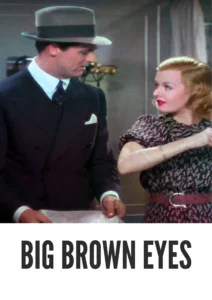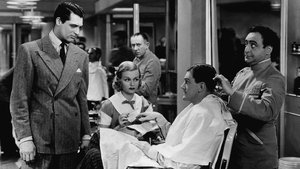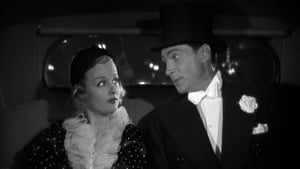Contact: [email protected]
Video Sources 0 Views
- Big Brown Eyes

Synopsis
Table of Contents
ToggleReview: Big Brown Eyes (1936) – A Classic Romantic Comedy Illuminated in Vivid Color

Introduction
“Big Brown Eyes” (1936) offers a delightful escapade into the world of romantic comedy, capturing the hearts of audiences with its charming wit and endearing characters. In this article, we’ll explore the significance of this early colored film, shedding light on its enduring appeal and timeless charm.
Check The Full Colorized Movies List
Check Our Colorized Movies Trailer Channel
Understanding Big Brown Eyes 1936: Director, Cast, and Genre
Directed by Raoul Walsh, “Big Brown Eyes” (1936) showcases his adeptness at crafting lighthearted romances that tug at the heartstrings. The film features a talented cast, including the effervescent Joan Bennett and the charismatic Cary Grant, whose on-screen chemistry sparkles with wit and charm. Blending elements of comedy, romance, and mystery, “Big Brown Eyes” (1936) transports viewers to a world where love and laughter abound.
Exploring the World of Big Brown Eyes 1936: Plot and Characters
At its core, “Big Brown Eyes” (1936) follows the misadventures of a vivacious manicurist, played by Joan Bennett, and a dashing newspaperman, portrayed by Cary Grant, as they find themselves entangled in a web of intrigue and romance. As they navigate the twists and turns of a murder mystery, they discover that love can be found in the most unexpected of places. Along the way, they encounter a colorful cast of characters who add depth and humor to their journey.
The Art of Film Colorization
Film colorization serves as a transformative tool that breathes new life into classic movies, allowing audiences to experience beloved stories in vibrant color. By adding color to black and white films, colorization enhances the visual appeal of timeless tales and invites viewers to rediscover familiar worlds with fresh eyes and renewed enthusiasm.
Early Colored Films: A Brief History
The history of colored films traces its origins back to the early days of cinema, with filmmakers experimenting with various techniques to add color to their creations. From hand-tinted frames to early Technicolor processes, the evolution of colored film has been marked by innovation and creativity, paving the way for the development of modern colorization techniques that continue to captivate audiences today.
Big Brown Eyes 1936 and Its Early Colored Version
The decision to release “Big Brown Eyes” (1936) in a colorized format was met with both excitement and trepidation. While some welcomed the opportunity to experience the film in vibrant color, others expressed concerns about the potential impact on its visual aesthetic. Nevertheless, the early colored version of “Big Brown Eyes” (1936) offers viewers a fresh perspective on the classic romantic comedy, enhancing its charm and whimsy with vivid hues and luminous beauty.
The Debate Over Film Colorization
The debate over film colorization has long been a contentious issue in the world of cinema, with proponents praising its ability to revitalize classic movies and introduce them to new audiences, while detractors argue that it compromises the artistic integrity of the original work. As the debate rages on, filmmakers and audiences alike are left to ponder the merits and drawbacks of colorization in the ever-evolving landscape of cinema.
Examining Big Brown Eyes 1936 as an Early Colored Film
As with any colorized classic, the impact of colorization on “Big Brown Eyes” (1936) is a matter of personal interpretation. Some may argue that it enhances the film’s visual appeal and immerses viewers in its world, while others may feel that it detracts from the nostalgic charm of the original black and white version. Regardless of one’s stance on the issue, there’s no denying the enduring power of “Big Brown Eyes” (1936) as a timeless romantic comedy that continues to delight audiences with its wit and charm.
Influence and Legacy: Big Brown Eyes 1936’s Impact on Cinema
“Big Brown Eyes” (1936) has left an indelible mark on the world of cinema, inspiring countless filmmakers and captivating audiences with its timeless tale of love and laughter. From its sparkling performances to its witty dialogue, the film remains a beloved classic that continues to resonate with viewers of all ages, reaffirming its status as a true gem of the romantic comedy genre.
Director’s Cinematic Legacy: Beyond Big Brown Eyes 1936
Raoul Walsh’s influence extends far beyond “Big Brown Eyes” (1936), with a prolific body of work that spans multiple genres and decades. From “High Sierra” to “White Heat,” Walsh’s films are celebrated for their bold storytelling, dynamic characters, and visceral action sequences, solidifying his legacy as one of the preeminent directors of Hollywood’s Golden Age. Through his groundbreaking work, Walsh has left an indelible imprint on the world of cinema, inspiring generations of filmmakers to push the boundaries of storytelling and visual expression.
Themes Explored in Big Brown Eyes 1936
“Big Brown Eyes” (1936) explores a myriad of themes, from the transformative power of love to the importance of following one’s heart in the pursuit of happiness. Through its charming characters and witty banter, the film invites viewers to embrace life’s unpredictability and revel in the joy of love and laughter. As audiences immerse themselves in the world of “Big Brown Eyes” (1936), they are reminded of the enduring truths that bind us together and the universal quest for happiness and fulfillment.
Reception and Controversy Surrounding Big Brown Eyes 1936
Upon its release, “Big Brown Eyes” (1936) received widespread critical acclaim, with many praising its sparkling performances, witty dialogue, and captivating romance. However, the decision to release the film in a colorized format sparked debate among purists, reigniting the age-old discussion surrounding film preservation and artistic integrity. Despite the controversy, “Big Brown Eyes” (1936) remains a beloved classic that continues to charm audiences with its timeless humor and heartwarming romance.
Where to Watch Big Brown Eyes 1936 Online
For those eager to experience the timeless magic of “Big Brown Eyes” (1936), the film is readily available on popular streaming platforms such as Netflix, Amazon Prime, and Hulu. Whether you choose to watch it in its original black and white format or the early colored version, “Big Brown Eyes” (1936) promises to whisk you away on a delightful journey filled with laughter, love, and endless charm.
FAQs About Big Brown Eyes 1936
Q: Is “Big Brown Eyes” (1936) based on a true story? A: No, “Big Brown Eyes” (1936) is a fictional romantic comedy crafted by screenwriter Bert Hanlon, whose wit and charm infuse the film with timeless appeal.
Q: Who are the main actors in “Big Brown Eyes” (1936)? A: “Big Brown Eyes” (1936) features a talented cast led by the delightful Joan Bennett and the charming Cary Grant, whose on-screen chemistry lights up the screen with humor and romance.
Q: What awards did “Big Brown Eyes” (1936) win? A: While “Big Brown Eyes” (1936) did not win any major awards, it received critical acclaim for its sparkling performances and witty dialogue, solidifying its status as a beloved classic of the romantic comedy genre.
Q: Why was “Big Brown Eyes” (1936) released in a colorized format? A: The decision to release “Big Brown Eyes” (1936) in color was made to introduce the film to a new generation of viewers and enhance its visual appeal for modern audiences. While the choice to colorize the film sparked debate among purists, it ultimately allowed “Big Brown Eyes” (1936) to reach a wider audience and ensure its continued relevance in the annals of cinematic history.
Conclusion
“Big Brown Eyes” (1936) is a timeless romantic comedy that continues to capture the hearts of audiences with its sparkling wit, endearing characters, and timeless charm. Whether viewed in its original black and white format or the early colored version, the film remains a beloved classic that reminds us of the enduring power of love and laughter to brighten even the darkest of days. So, grab some popcorn, settle in, and let the magic of “Big Brown Eyes” (1936) sweep you off your feet on a delightful journey filled with laughter, love, and endless charm.












